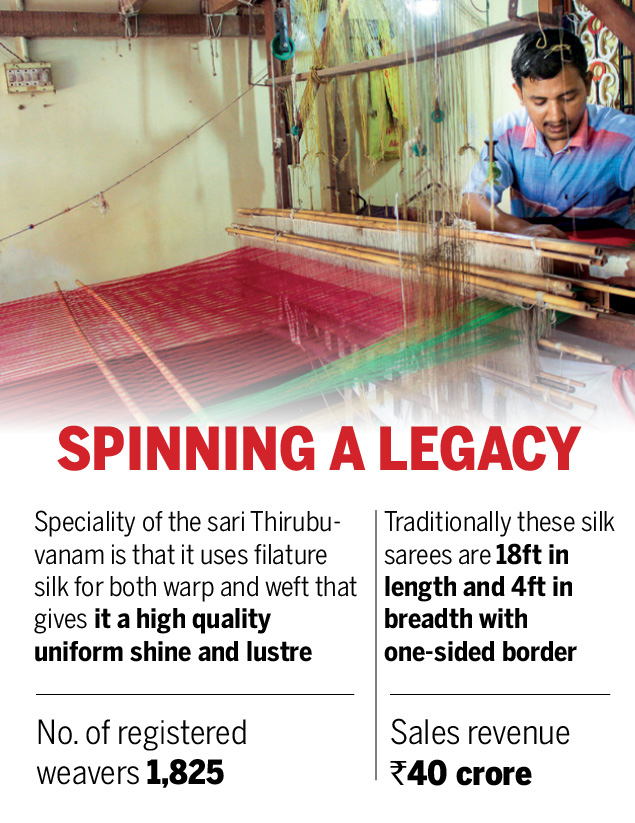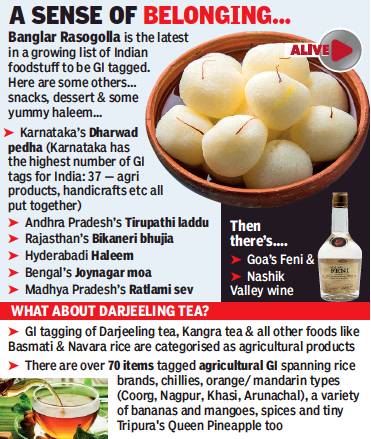Geographical Indication and India
This is a collection of articles archived for the excellence of their content. |
Contents |
Geographical indication
Mamtha Asokan, Aparna Desikan and D Vincent Arockiaraj, July 24, 2020: The Times of India
Geographical indication (GI) tag is a sign used on products that have a specific geographical origin and possess qualities or a reputation that are due to that origin. In order to function as a GI, a sign must identify a product as originating in a given place. In addition, the qualities, characteristics or reputation of the product should be essentially due to the place of origin. Since the qualities depend on the geographical place of production, there is a clear link between the product and its original place of production.
Enforceability of GI tags
Rupali Mukherjee, ’GI tag not extendable to unrelated biz’, February 6, 2019: The Times of India

From: Rupali Mukherjee, ’GI tag not extendable to unrelated biz’, February 6, 2019: The Times of India
While corporate battles protecting patents and trademarks are fairly common, the right to enforce a geographical indication (GI) tag has had a new twist. The Calcutta high court has ruled that Darjeeling Tea as a GI — owned by the government-run Tea Board — for tea originating from the region cannot be claimed for unrelated goods or services.
The order came on a case filed by the Tea Board against hotels-to-tobacco conglomerate ITC in 2010 for operating a premier lounge — ‘Darjeeling Lounge’ — at its ITC Sonar Hotel in Kolkata. The plea was dismissed as the court ruled that the GI held by Tea Board is restricted to only goods (tea), and not to services such as lounges.
Simply put, GI are names, geographical or figurative representation conveying or suggesting the ‘geographical’ origin of the products. The HC order is one of the first interpreting rights available to a GI holder, which legal experts say will help in defining the ambit of protection provided by GI law in India.
GIs registered in India include Darjeeling Tea, Mysore Sandal Soap, Alphonso mango and Surat Zari Craft. The Tea Board was attempting to monopolise the name Darjeeling for itself for all goods and services, even though they have a registration for only tea. Such claim has been denied by court, said Kironjit B Majumder from S Majumdar & Co, the law firm representing ITC.
The Geographical Indications of Goods (Registration and Protection) Act was enacted in India in September 2003, and soon thereafter the Tea Board filed and obtained registration for the GI ‘Darjeeling’. It then filed opposition to the registration of ITC’s application for registration of the trade mark Darjeeling Lounge, citing infringement of GI and Certification Trade Marks. Thereafter, it filed a suit in 2010, seeking interim injunctions against ITC to restrain the company for using Darjeeling Lounge.
In its suit, Tea Board said ‘Darjeeling’ is associated exclusively with ‘Darjeeling Tea’, and use of ‘Darjeeling’ in respect of lounge services is detrimental to the distinctive character of its GI. Also, use of ‘Darjeeling Lounge’ is an act of unfair competition, and has the effect of causing confusion among guests visiting the lounge, and guests would believe that there is some association of Darjeeling Lounge with Darjeeling Tea, or the Tea Board.
Business
As in Jan 2020

From: Mamtha Asokan, Aparna Desikan and D Vincent Arockiaraj, July 24, 2020: The Times of India

From: Mamtha Asokan, Aparna Desikan and D Vincent Arockiaraj, July 24, 2020: The Times of India
The main period of business, the marriage season begins from Sankranti (January 15) and lasts till the beginning of Aadi (July 15).
The wedding budget of garments [till Dec 2019 was] ₹1 lakh per family. “People [would] buy the wedding sari for the bride, ‘samandhi’ (gifted to the in-laws) saris and veshti/dhoti for the groom. The traditional practice of gifting saris for weddings [was] there.,” says Chetty.
With rising gold and silver prices, silk sari manufacturers are now adopting new strategies such as reducing the size of the sari border from four inches to two or 1.5 inches. Others like Prakash Sah, owner of Kancheepuram-based Prakash Silks, keeps employees busy by making synthetic zari instead of silver. “One needs to sell silverbased zari within 2-3 months of making the saree. That seems impossible at this point and we are changing our strategy,” he says.
One needs to sell silver-based zari within 2-3 months of making the saree.
The shelf-life of a silk sari is five years, and needs to be refolded every week for better longevity. The rate of pure silk stands at ₹4,000/kg and is sourced from Bengaluru and this rate could go up if silk import from China gets banned
Prasad Pannerselvam of P S Silk Sarees, employs 169 weavers
Handloom weaver K Krishnamurthy of Kancheepuram said a weaver gets wages between Rs 15,000 and Rs 25,000 depending on the orders every month.
On an average, weavers make more than one lakh handloom silk sarees every year. These are bought by tourists and marriage shoppers who throng Kancheepuram.
The silk saris created by the weavers in the temple town of Thirubuvanam near Kumbakonam in Thanjavur district are famous for the rich zari work and fine silk.
In March 2019, the unique weaving technique of the region that uses filature silk for warp and weft that results in superior quality fabric, got the GI tag. Adorned with pure zari work, the ‘pallu’ of the sari is continuously woven on the loom and runs on from the body, unlike other saris where the body and ‘pallu’ are woven separately.
But before the GI recognition could guarantee it the prized status, the economy [was] hit.
N D Nagendran, district president of AITUC for weavers’ wing said, “Every year the society does business to the tune of ₹40 crore.
The weaving tradition is tied to the Sourashtra community, who were known for their handloom saris and had settled down in Thirubuvanam during the period of Nayaks and Marathas. More than 1,500 families are engaged in making the handloom sari, for ₹3,000 to ₹6,000 per piece, under the Thirubuvanam Silk Handloom Weavers
Cooperative society that distributes raw material to the weavers. [Before Covid], raw material to make up to 50 saris per month used to be distributed
As gold-coated silver zari is used for weaving, the skyrocketing of gold rates is further adding to production woes.
Products, in brief

From: November 15, 2017: The Times of India
See graphic:
Geographical Indication (GI) tag, some important items to be tagged, as in November 2017